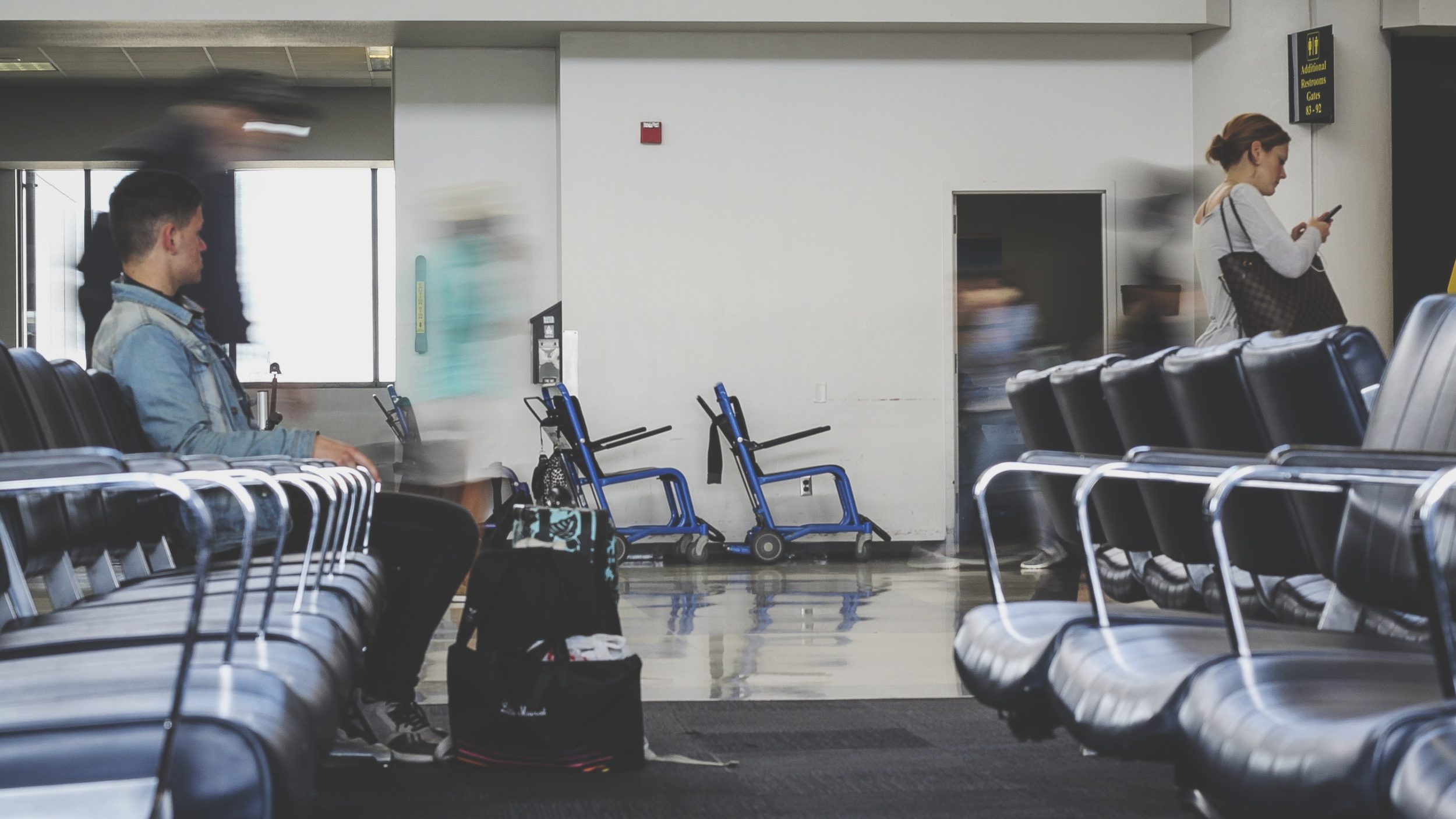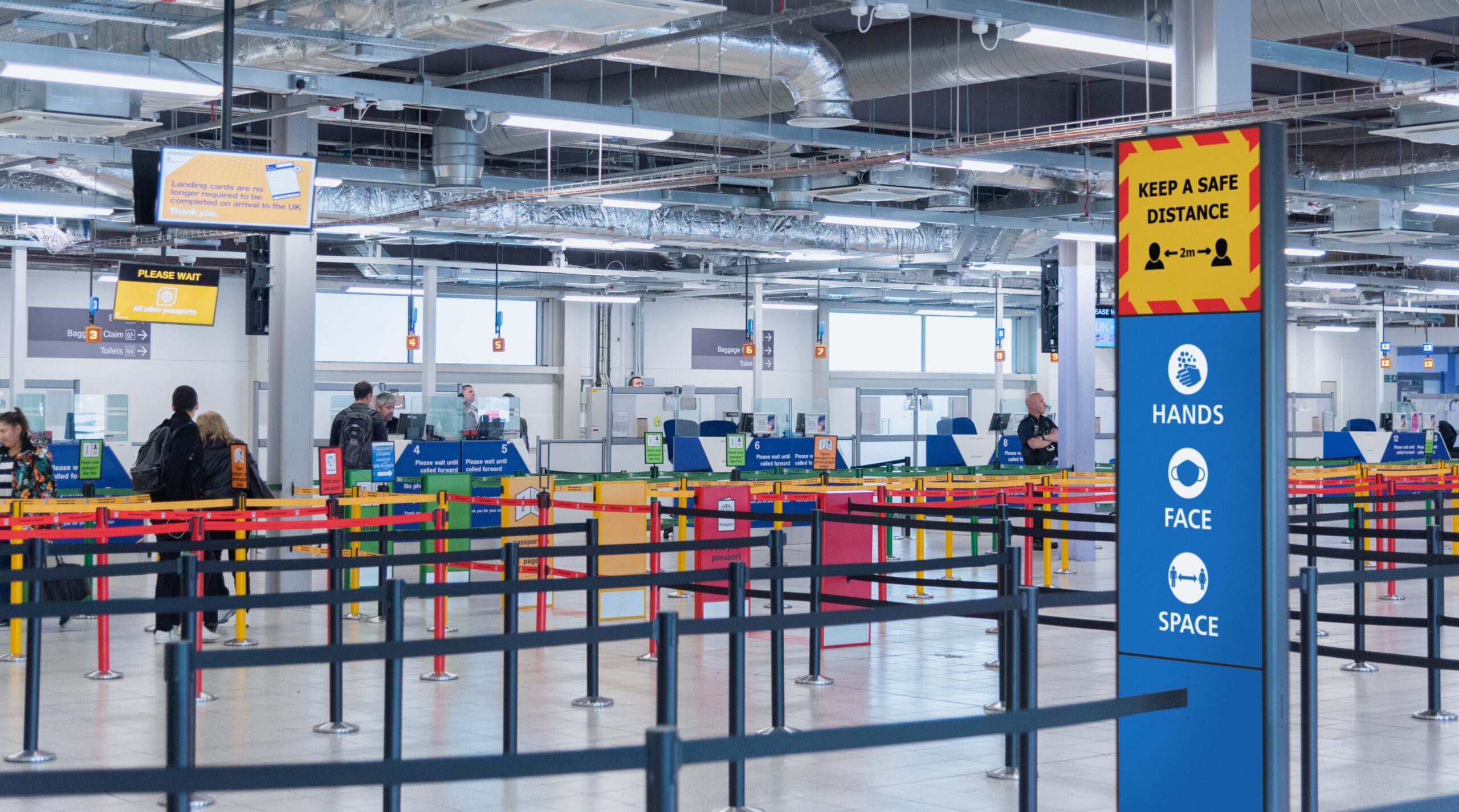- Home
- Sectors
- Solutions
- Tensabarrier®
- Tensamedia® Wayfinding and Signage
- Lawrence® Post & Rope
- Tensator® Airport Passenger Guidance System
- Electronic Queuing – eQ™
- Tensaguide® Modular Barrier System
- Tensator Micam Protection – TMP
- Safety Solutions
- Access Control
- In-Queue Merchandising
- Virtual Queuing – VQMS
- Tensator® Virtual Assistant
- Custom & Bespoke Solutions
- Resources
- About
- Contact Us
- Shop
 English (English)
English (English)
11
Jul

Like any other customer-facing industry, ensuring first-class airport passenger flow is crucial for staff working across the aviation industry. With factors such as delays, queues and long walking times between terminals often inevitable, managing these difficulties alongside meeting passenger expectations is key to enhancing air travel for disabled passengers.
This complexity presents a challenge, particularly when considering the varying needs of all passengers using airports daily. Facilities managers must consider those with heavy luggage, wheelchairs, pushchairs and sight or mobility issues, as well as ‘hidden’ conditions such as autism, or memory difficulties. Therefore, ensuring a seamless customer experience is becoming a much more intricate task that requires increased consideration.
Meeting disabled customers’ needs and expectations in your airport
The Civil Aviation Authority’s (CAA) latest Airport Accessibility Report, released in August 2017, showed that the number of passengers with a disability travelling by air has grown by more than two thirds since 2010. Furthermore, requests for use of airport assistance services from these passengers also rose by more than 66 per cent within the same timescale.
Of all the UK airports that were assessed as part of this report, the majority were found to offer a good service for disabled travellers. However, four were rated ‘poor’ when measured against factors such as waiting times, engaging with disability groups and customer satisfaction survey scores.
A draft transport accessibility action plan was also revealed by the Department For Transport last year, which covers a range of transport modes including aviation. With its aim to ensure people with disabilities have equal opportunity to travel, the plan offers recommendations on how to improve transport accessibility, based on in-depth consultations with key stakeholders. Suggestions such as increasing the number of accessible vehicles given to taxi authorities were made, as well as improving ‘alternative journey options’ on trains if the only disabled toilet on board becomes unexpectedly out of use, for example. It also encourages feedback on each action proposed from the general public.
Clearly, there is increasing pressure on airports to do more for disabled citizens, and alongside the requirements of The Equality Act 2010, failure to do so is unlawful. But the true benefits of making all customers feel at ease within airports lie far beyond simply ticking legal boxes.
The power of the ‘Purple Pound’
Over 13 million disabled people live in the UK of who, according to the CAA, are travelling by air more now than ever. Known as the ‘purple pound’, the spending power of this demographic is estimated to be worth over £249 billion to the UK economy, while those aged 50 or over, the ‘silver pound’, spent more money than younger generations in 2016 – a trend that is expected to continue.
Catering towards these passengers with huge spending power, as well as their specialist needs, is important for commercial prosperity in addition to ever-increasing ethical and legal requirements.
How to improve the experience of air travel for disabled passengers
While travelling by air can be one of the most exciting parts of a trip, many passengers are apprehensive of aeroplanes and can find airports incredibly stressful. This can be amplified for travellers with a physical or hidden disability. What’s more, the journey often plays a critical part in a traveller’s overall experience and is a prime memory of any trip. It’s therefore critical to create a seamless experience for all passengers to eradicate any unnecessary tension or stress, keeping in mind the needs of vulnerable and disabled customers too.
Adhering to criteria within CAA’s Airport Accessibility Report, this can be improved by partnering with local disability organisations to identify each airport’s specific challenges. Investing in its assistance service, whether outsourced to a contractor or managed in-house, is also crucial to improving access in each airport and increasing confidence in disabled passengers. A closer look at terminal layout is another key factor that could affect a customer’s overall experience.
During delays, queues can quickly form with a backlog of passengers, making terminals crowded, disorderly and in some instances, dangerous. Here, passenger flow is a critical factor to successfully manage long waiting times and ease congestion in airports.
The use of barriers and other queue management systems are common techniques used to manage queues, but considerations must be made for those with wheelchairs, walking aids, trolleys or buggies who may find navigating such areas difficult.
Tensator have developed solutions such as the low-profile universal base for Tensabarriers® which allow wheels to pass over the edge of an existing Tensabarrier® more easily, reducing the risk of stalling, trips and falls when moving through busy lines. They can also enable passengers to independently pass through particular areas, without the need for special assistance routes. Although a simple switch, such measures can ensure a substantial increase in satisfaction levels for airline passengers with reduced mobility.
Increase in passenger satisfaction
According to the CAA’s report, airports that rated well in areas including waiting time performance targets and customer satisfaction surveys performed best overall. In addition to strengthening special assistance services, this reiterates the wider importance of addressing delays and queue management when examining accessibility within airports and creating a streamlined customer experience for all.
Beyond the aviation sector, all transport hubs including rail and coach stations can instigate such techniques to improve accessibility for passengers with disabilities. Doing so is a vital step towards improving passenger satisfaction and inclusivity within the UK’s biggest transport hubs, regardless of how people choose to travel.
Through our work with airports and airlines globally we understand the challenge to always look for ways to enhance the passenger journey and experience, as well as increase safety, create efficiencies and reduce costs. As the global market leader of queue management products within the airport sector, our solutions are tailored to your needs and to meet your objectives. To find out more about how Tensator can help with enhancing air travel for disabled passengers, download our airport guide.





